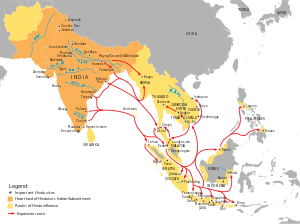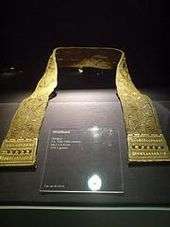Religion in pre-colonial Philippines
| Part of a series on the |
| Culture of the Philippines |
|---|
 |
| History |
| People |
| Languages |
| Traditions |
| Cuisine |
| Festivals |
| Religion |
| Art |
| Literature |
|
Music and performing arts |
|
Monuments |
|
There is little evidence remaining of the nature of religion in pre-colonial Philippines. The possibilities include animism, Philippine mythologies such as Anito, and influences from Hinduism and Buddhism. The earliest pieces of evidence that exist are archaeological finds including Hindu- Buddhist gold statues. The earliest written evidence comes from the Laguna Copperplate Inscription, dated to around 900 CE, which uses the Buddhist-Hindu lunar calendar. With the arrival of Islam in the 14th century, the older religions gradually disappeared, and after the arrival of Ferdinand Magellan in 1521 Christianity became the dominant religion. However, some of the indigenous Philippine tribes continue to practice animism today, and many of the traditions in Anito have been Christianized and turned into Folk Catholicism.
Records
The most of records about what is the religion of the Philippines before the arrival of the Spaniards are can be traced back through the various written accounts from the Chinese, Indic and Spanish sources.
- The Laguna Copperplate Inscription (LCI)
- Zhu Fan Zhi (Chinese: 諸番志; literally: ""Account of the Various Barbarians"")
- Boxer Codex- Spanish written accounts
LCI
The Laguna Copperplate Inscription (LCI) is the most significant archaeological discovery in the Philippines because it serves as the first written record of the Philippine nation. The LCI mentions a debt pardon for a person, Namwaran, and his descendants by the Rajah of Tundun (now Tondo, Manila) on the fourth day after Vaisakha, in the Saka year 822, which has been estimated to correspond to 21 April 900 CE. Vaisakha is a date in the old Buddhist-Hindu lunar calendar.
Antoon Postma, an anthropologist and an expert in ancient Javanese literature, has deciphered the LCI and he says it records a combination of old Kavi (an ancient Javanese language), Old Tagalog (a Philippines dialect), and Sanskrit.[1]
For The LCI's transliteration,see the
Animism and Folk religion

The Forms of animism was widely practiced in the Philippines. Today, the Philippines is mostly Catholic and other forms of Christianity, and only a handful of the indigenous tribes continue to practice the old traditions. These are a collection of beliefs and cultural mores anchored more or less in the idea that the world is inhabited by spirits and supernatural entities, both good and bad, and that respect be accorded to them through nature worship. These spirits all around nature are known as "diwatas", showing cultural relationship with Hinduism (Devatas).
Some worship specific deities, such as the Tagalog supreme deity, Bathala, and his children Adlaw, Mayari, and Tala, or the Visayan deity Kan-Laon. Others practice Ancestor worship (anitos). Variations of animistic practices occur in different ethnic groups. Magic, chants and prayers are often key features. Its practitioners were highly respected (and some feared) in the community, as they were healers, midwives (hilot), shamans, witches and warlocks (mangkukulam), priests/priestesses (babaylan/katalonan), tribal historians and wizened elders that provided the spiritual and traditional life of the community. In the Visayan regions, shamanistic and animistic beliefs in witchcraft (barang) and mythical creatures like aswang (vampires), duwende (dwarves), and bakonawa (a gigantic sea serpent) Similarly to Naga, may exist in some indigenous peoples alongside more mainstream Christian and Islamic faiths.
Anito
Anito is a collective name for the pre-Hispanic belief system in the Philippines. It is also used to refer to spirits, including the household deities, deceased ancestors, nature-spirits nymphs and diwatas (dryads). Ancient Filipinos kept statues to represent these spirits, ask guidance and magical protection. Much of the tradition has been Christianized and incorporated into Folk Catholicism.
Anito is an ancient Tagalog faith. A belief where there is one God above all with high respect to all gods creations. Respect of elders and ancestors and environment are highly regarded.
Folk Healers
During the pre-Hispanic period, babaylan, functioned as shamans and spiritual leaders and mananambal were for folk healers. At the onset of the Colonial era, the suppression of the babaylans and the native Filipino religion gave rise to the albularyo. By exchanging the native prayers and spells with Catholic oraciones and Christian prayers, the albularyo was able to synchronize the ancient mode of healing with the new religion.
Buddhism


Although no written record exists about the early Buddhism in the Philippines, The recent archaeological discoveries and the few scant references in the other nations’s historical records can tell, however, about the existence of Buddhism from the 9th century onward in the islands. These records mention the independent states that comprise the Philippines and which show that they were not united as one country in the early days.
The Philippines’s early states must have become the tributary states of the powerful Buddhist Srivijaya empire that controlled the trade and its sea routes from the 6th century to the 13th century in Southeast Asia. The states’s trade contacts with the empire long before or in the 9th century must have served as the conduit for introducing Vajrayana Buddhism to the islands.
In 1225, China's Zhao Rugua, a superintendent of maritime trade in Fukien province wrote the book entitled Zhu Fan Zhi (Chinese: 諸番志; literally: ""Account of the Various Barbarians"") in which he described trade with a country called Ma-i in the island of Mindoro in Luzon,(pronounced "Ma-yi") which was a prehispanic Philippine state. In it he said:
The country of Mai is to the north of Borneo. The natives live in large villages on the opposite banks of a stream and cover themselves with a cloth like a sheet or hide their bodies with a loin cloth. There are metal images of Buddhas of unknown origin scattered about in the tangled wilds.
.[2]
In the 12th century, Malay immigrants arrived In Palawan, Most of their settlements were ruled by Malay chieftains. They were followed by the Indonesians of the Majapahit Empire in the 13th century, and they brought with them Buddhism.
Surviving Buddhist images and sculptures are primarily in and near Tabon Cave.[3] Recent research conducted by Philip Maise has included the discovery of giant sculptures, has also discovered what he believes to be cave paintings within the burial chambers in the caves depicting the Journey to the West.[4]
Ritual practice rather than meditation makes Vajrayana Buddhism distinct from the other forms of Buddhism. Vajrayana Buddhism was also known as Tantric Buddhism and Mantrayana, the esoteric teaching, which was conveyed only by a master to a disciple through initiation or empowerment. Vajrayana means Adamantine Vehicle or Diamond Vehicle that shows the way to awaken the Enlightenment. Mantrayana comes from the word mantra, which means words (incantation, spell, oath) of special vibrations. Mantrayana makes use of upaya or skillful means, such as the mantra and the mandala. They serve as aids to mind cultivation.\
The Chinese annal Song Shih recorded the first appearance of a Butuan tributary mission (Li Yui-han 李竾罕 and Jiaminan) at the Chinese Imperial Court on March 17, 1001 AD and it described Butuan (P'u-tuan) as a small Hindu country with a Buddhist Monarchy in the sea that had a regular connection with the Champa kingdom and intermittent contact with China under the Rajah named Kiling.[5]
Lunar observations
- Subang - new moon
- Gimat/ungut - full crescent
- Hitaas na an subang - high new moon (3rd day)
- Balining - the 4th or 5th night
- Odto na anbalan - quarter moon
- Dayaw/paghipono/takdul/ugsan - full moon
- Madulumdulum - waning moon
- Banolor - night or 2 later of waning, set on Western horizon just before dawn.
- Parik - 5th or 6th night of waning
- Katin - 3rd quarter so it crossed the 2nd barrier by the 24th or 25th night.
- Malasumbang - 29th night; getting ready for the new moon.
Hinduism

The archipelagoes of Southeast Asia were under the influence of Hindu Tamil, Gujarati and Indonesian traders through the ports of Malay-Indonesian islands. Indian religions, possibly an amalgamated version of Hindu-Buddhism arrived in the Philippine archipelago in the 1st millennium, through the Indonesian kingdom of Srivijaya followed by Majapahit. Archeological evidence suggesting exchange of ancient spiritual ideas from India to the Philippines includes the 1.79 kilogram, 21 carat gold Hindu goddess of Agusan (sometimes referred to as Golden Tara), found in Mindanao in 1917 after a storm and flood exposed its location.[6] The statue now sits in the Field Museum of Natural History in Chicago, and is dated from the period 13th to early 14th centuries.
A study of this image was made by Dr. F. D. K. Bosch, of Batavia, in 1920, who came to the conclusion that it was made by local workmen in Mindanao, copying a Ngandjuk image of the early Madjapahit period - except that the local artist overlooked the distinguishing attributes held in the hand. It probably had some connection with the Javanese miners who are known to have been mining gold in the Agusan-Surigao area in the middle or late 14th century. The image is apparently that of a Sivaite goddess, and fits in well with the name "Butuan" (signifying "phallus").
Juan Francisco suggests that the golden Agusan statue may be a representation of goddess Sakti of the Siva-Buddha (Bhairava) tradition found in Java, in which the religious aspect of Shiva is integrated with those found in Buddhism of Java and Sumatra.[8]
Folklore, arts and literature
Many fables and stories in Filipino Culture are linked to Indian arts, such as the story of monkey and the turtle, the race between deer and snail (slow and steady wins the race), and the hawk and the hen. Similarly, the major epics and folk literature of Philippines show common themes, plots, climax and ideas expressed in the Mahabharata and the Ramayana.[9]
According to Indologists Juan R. Francisco and Josephine Acosta Pasricha, Hindu influences and folklore arrived in Philippines by about 9th to 10th century AD.[10] The Maranao version is the Maharadia Lawana (King Rāvaṇa of Hindu Epic Ramayana). Lam-Ang is the version of the Ilocanos and Sarimanok (Indian Garuda) is the legendary bird of the Maranao culture. In addition, many verses from the Hud-Hud of the Ifugao are derived from the Indian Hindu epics Ramayana and the Mahabharata.[11]
Buddhist-Hindu Influences in culture
The Darangen or Singkil epic of the Maranao people hearten back to this era as the most compete local version of the Ramayana. The Maguindanao at this time also had strong Hindu beliefs, evidenced by the Ladya Lawana (Rajah Ravana) epic saga that survives to the modern day, albeit highly islamized from the 17th century onwards,
Tigmamanukan (Garuda)
The Tigmamanukan - blue and black bird Garuda that symbolized/vehicle of Bathalang Maykapal in which it was also an omen. If one encountered a Tigmamanukan flying in their voyage path, they should take note of the direction of its flight. If the bird‘s flight direction goes to the right, the traveler would not encounter any danger during their journey. If it flew to the opposite direction (meaning from right to the left) the traveler will never find its way and will be lost forever.
Ancient artifacts
The Philippines's archaeological finds include many ancient gold artifacts.[12][13] Most of them have been dated to belong to the 9th century.
The artifacts reflect the iconography of the Vajrayana Buddhism and its influences on the Philippines’s early states.[14]
Some of the artifacts found
| Name | Image | Description |
|---|---|---|
| Ling ling-O | * The artifacts’s distinct features point to their production in the islands. It is probable that they were made locally because archaeologist Peter Bellwood discovered the existence of an ancient goldsmith’s shop that made the 20-centuries-old lingling-o, or omega-shaped gold ornaments in Batanes. | |
| Further information: Tara (Buddhism) and Mahavidya |  | * The Golden Tara was discovered in 1918 in Esperanza, Agusan by Bilay Campos a Manobo tribeswoman.[15] The Golden Tara was eventually brought to the Field Museum of Natural History in Chicago, Illinois in 1922. Henry Otley Beyer, , and some experts have agreed on its identity and have dated it to belong within 900-950 CE. They can not place, however, its provenance because it has distinct features.[16] |
| Golden Kinnari |  | * The golden-vessel kinnari was found in 1981 in Surigao. The kinnari exists in both Buddhist and Hindu mythology. In Buddhism, the kinnari, a half-human and half-bird creature, represents enlightened action. The Buddhist Lotus Sutra mentions the kinnari as the celestial musician in the Himavanta realm. The kinnari takes the form of a centaur, however, in India's epic poem, the Mahabharata, and in the Veda's Purana part. |
| Golden Garuda of Palawan | * The other finds are the garuda, the mythical bird that is common to Buddhism and Hinduism,
| |
| Padmapani and Nandi images | * Padmapani is also known as Avalokitesvara, the wisdom being or Bodhisattva of Compassion.
Golden jewelry found so far include rings, some surmounted by images of Nandi - the sacred bull, linked chains, inscribed gold sheets, gold plaques decorated with repoussé images of Hindu deities.[17][18] | |
| Laguna Copperplate Inscription(LCI) |  | * In 1989, a laborer working in a sand mine at the mouth of Lumbang River near Laguna de Bay found a copper plate in Barangay Wawa, Lumban. This discovery, is now known as the Laguna Copperplate Inscription by scholars. It is the earliest known written document found in the Philippines, dated to be from the 9th century AD, and was deciphered in 1992 by Dutch anthropologist Antoon Postma. The copperplate inscription suggests economic and cultural links between the Tagalog people of Philippines with the Javanese Medang Kingdom, the Srivijaya empire, and the Hindu-Buddhist kingdoms of India. This is an active area of research as little is known about the scale and depth of Philippine history from the 1st millennium and before. |
Rise of Islam

The Muslim Bruneian Empire under the rule of Sultan Bolkiah, who is an ancestor of the current Sultan of Brunei. He subjugated the Kingdom of Tondo which is ruled by Rajah Gambang during 1500. The aftermath of the battle was the formation of an alliance between the newly established Kingdom of Maynila (Selurong) and the Sultanate of Brunei, to crush the power of the Kingdom of Tondo and the subsequent installation of the Pro-Islamic Rajah Sulaiman into power. Furthermore, Sultan Bolkiah's victory over Sulu and Seludong (modern day Manila),[19] as well as his marriages to Laila Mecanai the daughter of Sulu Sultan Amir Ul-Ombra (an uncle of Sharifa Mahandun married to Nakhoda Angging or Maharaja Anddin of Sulu), and to the daughter of Datu Kemin, widened Brunei's influence in the Philippines.[20]
Islamization by forced conversion to the citizens of Tondo and Manila make the divisions into Muslim domains and installed Rajah Suleyman and Rajah Matanda in the south (now the Intramuros district) and the Buddhist-Hindu settlement under Raja Lakandula in northern Tundun (now Tondo.)[21] With the rise of Islam, other religions in the archipelago gradually disappeared.
- note: Rajah is a Hindu title and Sultan is an Islamic title for that era.
See also
- Ancient barangay
- Buddhism in the Philippines
- Deities of Philippine mythology
- Diwata
- Gabâ
- Hinduism in the Philippines
- History of the Philippines
- Kulam
Notes
- ↑ Antoon Postma, “The Laguna Copperplate Inscription,” Philippines Studies, 1992 40: 183-203.
- ↑ Prehispanic Source Materials: for the study of Philippine History" (Published by New Day Publishers, Copyright 1984) Written by William Henry Scott, Page 68.
- ↑ Camperspoint: History of Palawan. Accessed August 27, 2008.
- ↑ "'Great Sphinx' Found in Tabon Caves in Palawan". MetroCebu. 12 August 2015. Retrieved 9 February 2016.
- ↑ "Timeline of history". Retrieved 2009-10-09.
- ↑ Golden Tara Government of the Philippines
- ↑ H. Otley Beyer, "Outline Review of Philippine Archaeology by Islands and Provinces," Philippine Journal of Science, Vol.77,Nos.34 (July–August 1947),pp. 205-374
- ↑ Juan Francisco (1963), A Note on the Golden Image of Agusan, Philippine Studies vol. 11, no. 3 (1963): 390—400
- ↑ Maria Halili (2010), Philippine History, ISBN 978-9712356360, Rex Books, 2nd Edition, pp. 46-47
- ↑ Mellie Leandicho Lopez (2008), A Handbook of Philippine Folklore, University of Hawaii Press, ISBN 978-9715425148, pp xxiv - xxv
- ↑ Manuel, E. Arsenio (1963), A Survey of Philippine Folk Epics, Asian Folklore Studies, 22, pp 1-76
- ↑ Jesus T. Peralta, "Prehistoric Gold Ornaments CB Philippines," Arts of Asia, 1981, 4:54-60.
- ↑ Art Exhibit: Philippines' 'Gold of Ancestors' in Newsweek.
- ↑ Laszlo Legeza, “Tantric Elements in the Philippines PreHispanic Gold Arts,” Arts of Asia, 1988, 4:129-136.
- ↑ Agusan Gold Image only in the Philippines.
- ↑ Agusan Image Documents, Agusan-Surigao Historical Archives.
- ↑ Anna T. N. Bennett (2009), Gold in early Southeast Asia, ArcheoSciences, Volume 33, pp 99-107
- ↑ Dang V.T. and Vu, Q.H., 1977. The excavation at Giong Ca Vo site. Journal of Southeast Asian Archaeology 17: 30-37
- ↑ History for Brunei 2009, p. 41
- ↑ "Brunei". CIA World Factbook. 2011. Retrieved 13 January 2011.
- ↑ Teodoro Agoncillo, History of the Filipino People, p 22
